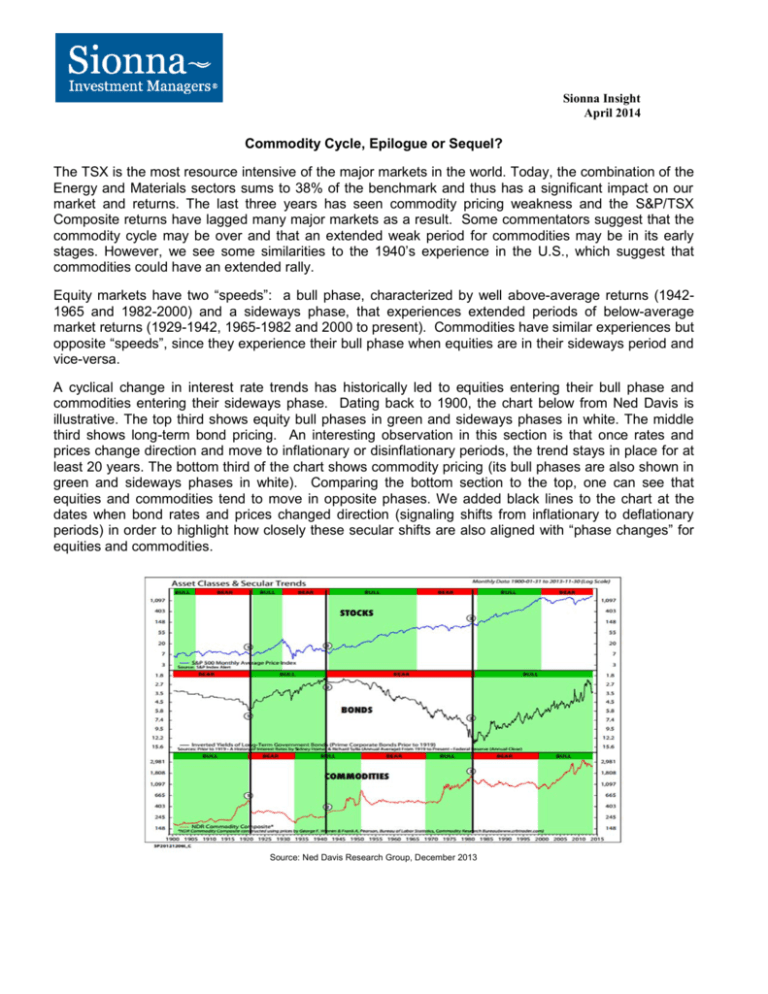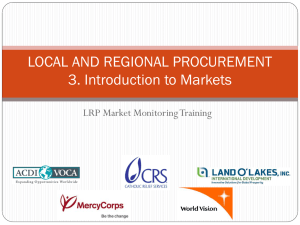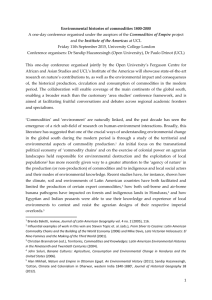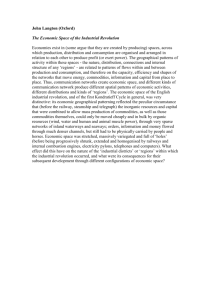Commodity Cycle, Epilogue or Sequel? The TSX is the
advertisement

Sionna Insight April 2014 Commodity Cycle, Epilogue or Sequel? The TSX is the most resource intensive of the major markets in the world. Today, the combination of the Energy and Materials sectors sums to 38% of the benchmark and thus has a significant impact on our market and returns. The last three years has seen commodity pricing weakness and the S&P/TSX Composite returns have lagged many major markets as a result. Some commentators suggest that the commodity cycle may be over and that an extended weak period for commodities may be in its early stages. However, we see some similarities to the 1940’s experience in the U.S., which suggest that commodities could have an extended rally. Equity markets have two “speeds”: a bull phase, characterized by well above-average returns (19421965 and 1982-2000) and a sideways phase, that experiences extended periods of below-average market returns (1929-1942, 1965-1982 and 2000 to present). Commodities have similar experiences but opposite “speeds”, since they experience their bull phase when equities are in their sideways period and vice-versa. A cyclical change in interest rate trends has historically led to equities entering their bull phase and commodities entering their sideways phase. Dating back to 1900, the chart below from Ned Davis is illustrative. The top third shows equity bull phases in green and sideways phases in white. The middle third shows long-term bond pricing. An interesting observation in this section is that once rates and prices change direction and move to inflationary or disinflationary periods, the trend stays in place for at least 20 years. The bottom third of the chart shows commodity pricing (its bull phases are also shown in green and sideways phases in white). Comparing the bottom section to the top, one can see that equities and commodities tend to move in opposite phases. We added black lines to the chart at the dates when bond rates and prices changed direction (signaling shifts from inflationary to deflationary periods) in order to highlight how closely these secular shifts are also aligned with “phase changes” for equities and commodities. Source: Ned Davis Research Group, December 2013 Sionna Insight April 2014 The one period in particular that pops up as an exception is the year 1941. It had been a period of falling interest rates (all-time North American low of 1.95% set in January 1941) and rising bond prices, and equities had been in an extended sideways market (1929 to 1942). In 1941, long-term government bond yields began an extended rally and equities entered a bull phase but, curiously, the commodity rally carried on for another decade, ending in 1951. Why did commodities not enter a sideways period in that cycle? We can only conjecture. Did the shift from a disinflationary to inflationary environment provide an additional boost to commodity prices so that the commodity cycle was propelled longer as a result? Possibly. Lack of ease in gathering historical aggregate commodity price data limits us in seeing whether any prior instances of this also existed. Was a secular shift in aggregate demand a contributor? 1941 was the middle of World War 2 (1939-1945) and commodities would have been in demand for the war effort. After the war was over, demand would have stayed high for post-war rebuilding. In addition, another factor that likely contributed to the commodity cycle being extended was meeting a resurgence of pent-up consumer demand and sudden household formations that had been delayed during the war. Today we find ourselves in a similar environment. We have been in a disinflationary environment for 30 years. Interest rates once again touched a North American record low of 1.46% in July 2012, besting the prior low set in 1941. With inflation still muted, the possibility remains that a new real return low could still be forged this cycle. Equities have also been in a sideways market since 2000. Today, we have aggregate demand growing with the rapid industrialization and investment in infrastructure of formerly “developing” nations; this development has led to a steadily increasing demand for more commodities as more of the world’s population shifts from poverty to the middle class. Escalating incomes have a direct impact on housing and consumables demand similar to the effect that post-war rebuilding demand had in the late 1940s. Thus, it may be possible that we have seen a mid-cycle correction in commodities that will be followed by a rally for several more years. The three-year weakness in commodities has brought their prices down to marginal cost of supply or lower. Commodity stocks, in general, are now fair to undervalued. Any further weakness will put the segment into bargain territory. Given this possibility and the emerging opportunities in energy and material stocks, it is prudent for Canadian investors to be open to, and prepared for, this contrarian possibility. As contrarian investors we are conditioned to look for situations when consensus in the market is emerging and then question whether it is wrong. In the current environment, we are willing to challenge the view that the commodity cycle is over for the foreseeable future. We do so however through the lens of relative value, and do not take significant sector bets. We believe the most reliable investment tool is to buy good quality stocks at attractive prices and hold them until they reach fair value or higher. Two to three years ago, commodity prices were well above their marginal cost of supply and we were underweight the sector, since valuations didn’t make sense. Fast forward to the current environment and it seems that more value is emerging in commodities. This historical perspective informs our current views and reminds us to remain open to outcomes that may differ from the consensus view. Because we see the possibility of an extended commodity cycle that others may ignore, we are prepared to take advantage of any emerging bargains for the benefit of our clients. Kim Shannon, CFA, MBA President & CIO Sionna Investment Managers









